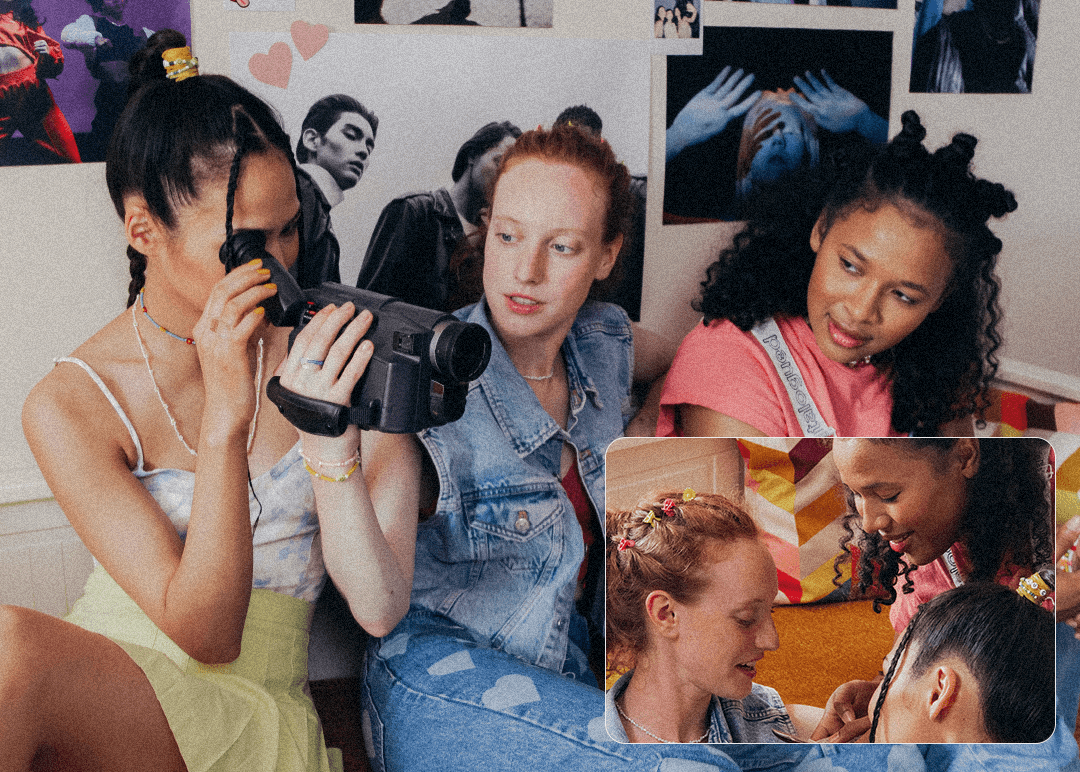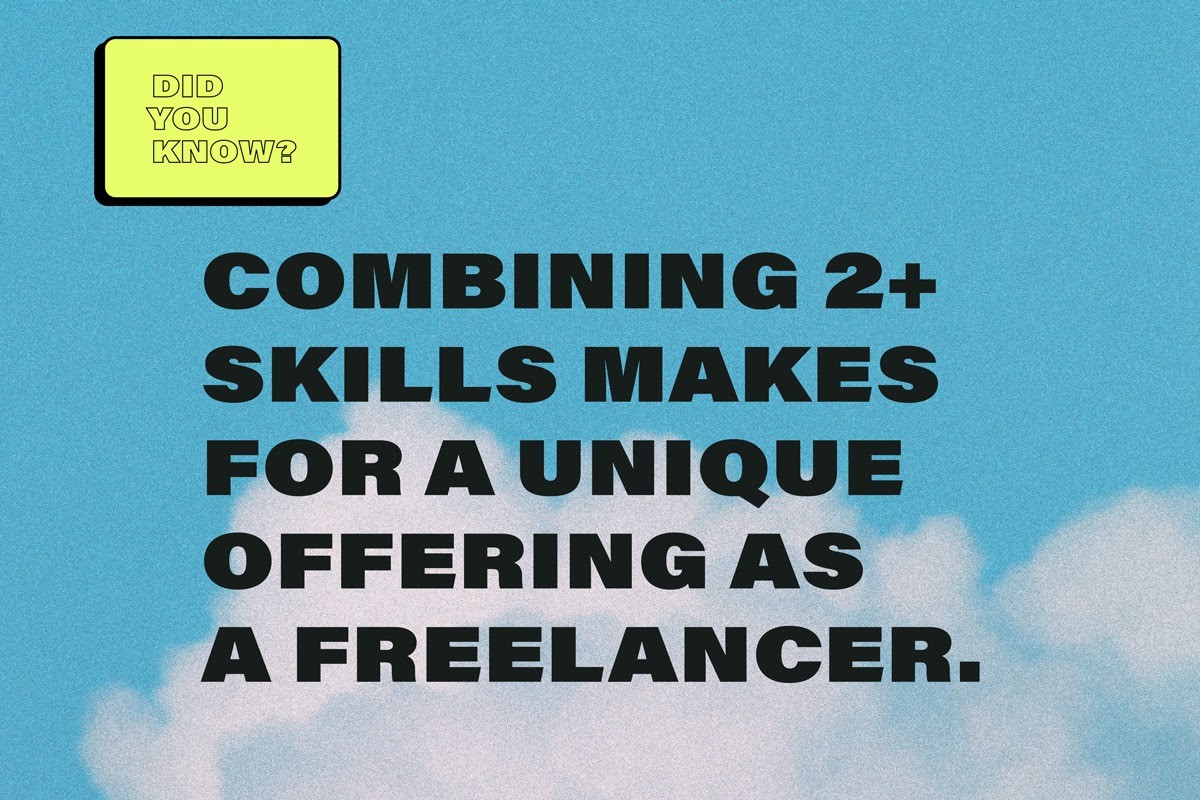How to Start Freelancing: 10 Steps to get Your Freelance Business Off the Ground

The numbers are out, and it’s no surprise that more people than ever are seeing freelancing as a long-term career path.
I mean, with many freelancers earning more per hour than 70% of the U.S. economy, can you blame them?
We think not 😏
We also think if there were ever a time to hop onboard, it’s this year.
If you caught our Ultimate Guide to Becoming a Freelancer in 2021, you’re already extremely familiar with the “official” steps you should take to kick your side gig up a notch.
But this time around, we’re mixing things up a bit 🥗
More and more kids are finding that the traditional path to rocking your freelance career is not the only path… As in, you can do things your way and still be successful.
This blog is written in that spirit.
So, join us on this journey as we explore 10 steps to get your freelance business off the ground.
This is your year. Let us help you rock it 🤘🏽
But First, Let’s Talk About What They Always Tell You When Starting Out - Don’t Quit Your Day Job
We admit we’ve even said this in the past, recommending you grow your side gig to 50 - 75% of your total current income before renouncing your full-time job.
While yes, it’s smart financial planning, there are plenty of success stories from entrepreneurs who did otherwise.

Oprah Winfrey, Ralph Lauren, and Steve Jobs are just a few prime examples of successful entrepreneurs who started with little to nothing.
Or even take a look at Cashmere Nicole.
She was a single mother fighting cancer and living on food stamps when she started her Black beauty brand, Beauty Bakerie, now valued at $40 million 💄
(Catch her and many others in our Black History Month: What Black Microentrepreneurs Can Learn From Black Business Leaders.)
Sure, maybe some had some sort of savings or small investment to fall back on, but the point is...
It really depends on how big of a risk taker you are 👀
✨ If you’re feeling like the stars are aligned, by all means, go all in, even before you’re “financially stable.”
(Who defines financial stability anyways??? Isn’t it subjective? 🙄 But that’s a convo for another day...)
Trust us when we say no one way is better than the next.
You have to decide what’s best for YOU.
OK, now that we have that awkwardness out of the way, it’s time to dive into what you came here for...
10 Steps to Get Your Freelance Business Off The Ground

As we touched on in the intro, we’re getting a bit creative with this list and doing things a liiiiiittle differently 😘
While some steps follow the “normal” path to becoming a freelancer, others may appear “out of order.”
But really, who’s judging? 🤷🏽♀️
Not us 🙅🏽♀️
So, without further adieu, leggo!
1. Find out what ticks your clock
You obviously want to get your freelance biz off the ground in something that interests you.
Or you’re gonna flatline pretty soon. #sadday
Pro tip? Mix where your interests are and where the money is.
🤔 And where’s the money? You might ask.
In niches, baybeeeee!
Combining two or more of your skills is a powerful way to make a unique offering.

Also, if you can market yourself in top industries according to current trends, you’ll do even better.
Let’s use ‘rona for example.
At-home workouts have SKYROCKETED 🚀 as people are looking for ways to stay fit and safe at home.
So, if you’re a fitness coach with an interest in occupational yoga, you could totally create video series on YouTube for helping people maintain good posture and such while they WFH, driving that traffic to other workout videos you may have on the platform.
Really, the options here are only as limited as your imagination 🌈
(And for all of you indecisive peeps out there, we actually wrote a blog earlier about 21 Ideas for Your New Freelance Business in 2021. You’re welcome 😄)
2. Put a name on it
To use your name or not?
That is the grand question 🧐
Truth is? It doesn’t matter what your name is as long as you love it.
It should also be an accurate representation of your company's vision.
Nevertheless, keep these tips in mind before you go HAM on it:
📄 Your name should adapt with your business. Opt for a name you won’t grow out of in five years or so. Or ya know, whenever you decide to pack up your bags and quit. (Hint: This may require you to create a business plan.)
💻 Search for it online. If you’re dead set on a specific name, you may want to try searching for it to see if it’s available on social channels, as a domain, with state authorities, and even as a trademark.
✅ Keep it simple. Don’t overcomplicate things. Remember, your name will be splayed literally everywhere you are - on- and offline. So, keep it easy on yourself and others.
For further reading, here are 5 tips for choosing a great small business name.
3. Slap some branding on your ish

After you pick your business name, it’s time to create a branding style guide.
Basically, what a branding style guide does is show you - and anyone else who’s on your team - what your company is all about visually 👁
With good branding, people will know your values, what you represent, the vibes you wanna give off, all that jazz… with just one glance.
👉🏽 Because first impressions are everything, yo.
Here’s our best advice for some of the main components of branding:
Colors:
Color psychology is definitely a thing.
Every time you see a color, you subconsciously associate it with a feeling, idea, or concept.
Some of the most famous associations are creativity for yellow 🌼, love for red ❤️, and spirituality for purple.
However, the real trick comes in balancing several colors to relay your brand values.
(This Know-It-All Guide to Color Psychology in Marketing talks more about this.)
Then, when you know more or less the colors you’d like for your biz, check out color palettes on Adobe Color.
Logo:
✔ Nike, McDonald’s, and Apple.
🤔 What do their logos have in common?
🌎 Everyone worldwide recognizes them.
Again, like the rest of your branding, a logo isn’t just something that you create and then slap on deliverables.
It’s kind of a big deal…. Think of it this way:
✅ Your logo follows you everywhere.
✅ It’s who you and your business are.
✅ And it’s used on literally everything.
We’re talkin’ your website; marketing materials (business cards, brochures, the like); invoices; to watermark any original content you make (videos, guides, photos, etc.); and more.
Here are six key principles of logo design to get you going.
Fonts:
Fonts are kind of like the middle child.
They’re forgotten about until something goes wrong 🤭

Changing the (touchy) subject, yes, typography plays a significant role in branding.
We admit we’re not experts in this. We just know it’s important.
So, we’re gonna pass this off to those who are experts in this nifty guide on everything you need to know about picking brand fonts.
Images:
📸 What types of photos will you use and in what instances?
For example, if you’re a freelance content writer, will you use stock photos for your personal blogs with GIFs & memes throughout?
Will you follow the same structure for any guides, case studies, etc. you write?
Colors will continue to play a huge role here, too.
But it’s super important to think of how you want the viewer to feel when seeing your images as well.
😃 If your brand is enthusiastic and happy, maybe you’ll only use stock photos of people smiling.
😐 If you’re more serious, maybe more solemn people will work better for you.
Again, it’s all about those vibes 💓
4. Set your pricing
Figuring out how much to charge is arguably one of the most uncomfortable steps of getting your freelance business off the ground because of how wishy-washy everyone is when it comes to money 💵
Again, we covered this in our Ultimate Guide to Becoming a Freelancer in 2021 (linked in the intro), but we’ll do a quick recap of how to set your prices:
🥾 How much does your ideal lifestyle cost? Do you need at least $200 a month for LE shoes? An extra $100 for Starbs? Tally it all up to see what you need to make annually to support your lifestyle. Then, work backwards - quarterly, monthly, and weekly - to get a better idea of what you need to charge.
📊 Use industry standards. When just starting off, it may be helpful for you to find others in your industry (with your level of experience and expertise), and gauge your prices based on theirs. This won’t always be 100% accurate, but it will give you a very good ballpark estimate.
🧑🏽🦱Consult other freelancers. Going off of the second point, other freelancers can also help you figure out how much to charge/ how much to sell your products for. Plus, they may give you additional tips you don’t find elsewhere when scouring the interwebs for industry standards.
💡 And here’s a bonus option: Charge based on the value you deliver.
With value-based pricing, you’re no longer fighting tooth and nail with the competition.
Instead, you stand your ground on your prices because you know what you can bring to the table.
It’s no longer just tit for tat.
👇🏽👇🏽👇🏽
For example, imagine you’re a freelance SEO content writer who charges a standard flat rate for every article that’s between 3,000 - 4,000 words.
But on top of that, you have a proven promotion strategy included in the flat rate that’s been proven effective with previous clients.
In other words, you’re not just selling an article. You’re also selling the traffic to go with it.
#genius
👆🏽👆🏽👆🏽
Anyways, No matter what you decide to charge, don’t forget taxes!!! 🧾

As a self-employed person, you’ll need to pay the employer’s AND employee’s share of self-employment tax, also known as social security tax, in addition to income tax (obvs).
Plan to set aside 25-30% of your earnings just for that.
Steep, we know. But it’s that price of freedom tho 😂🙊
Plus, remember you have to figure out benefits yourself, which also costs money.
(Companies like Catch and Sidecar Health make figuring this out easier for you.)
5. Start a shop on social to test the waters
OK, so you have the bare minimum needed to get the gears turning.
What better way to see how good your business idea is than to launch it on social?
Let the people be the judges 😈
Because millennials and Gen Z pretty much grew up with the internet, there’s honestly not much I can say here that you don’t already know.
But I will leave you with a decent article from our homeboys over at Hootsuite on how to improve your social media profiles in one hour or less.
For those too lazy to click the link, some key tips are:
@ Make sure handles are consistent
🏙 Check image sizes
🤳 Cross promote
🔗 Test links
⭐️ Pin the good stuff to the top of your profiles
If you want the rest, you’ll just have to read the article.
6. Do the work
So, a blog on how to start freelancing that includes 10 steps to get your freelance business off the ground wouldn’t be complete without the most obvious step.
You gotta put in the work!
Freelancing is the name of the game, and those dollas won’t start rolling in until you move some independent booty.

No one job marketplace is mightier than the next, but a few of the most popular floating around are Fiverr, Upwork, and Freelancer.
⚠️ Be warned some marketplaces take a hefty cut of your pay, though. (And don’t forget about those taxes you still have to pay…)
👉🏽 Or, you can start posting your own content on your social channels, and let clients come to you.
👌🏽 When done strategically and intentionally, it’s an easier way of getting paying customers, imho.
(And if you don’t have social proof yet, ask family and friends if they’d like the services/ products you’re offering. As long as they give you honest reviews, no harm no foul.)
7. Collect data from customers and make tweaks
If you weren’t a marketer before, well, you are now 🤣
Create. Test. Tweak. Repeat.
That’s kind of the name of the game in the digital world.
Really, the internet’s slogan is “Always be evolving” ™
(That’s probably not actually trademarked, but it should be cuz it’s that damn good.)
😟 Not sure how to even track data?
Surveys, quizzes, social media monitoring, and transactional data tracking (a.k.a. seeing which products sell better) are just a few methods of data collection.
❓Whichever way you choose, make sure you ask yourself these 10 questions when collecting customer data.
En fin, this part can be as simple or as complicated as you want.
The whole point here is to understand more about your target market so you can offer them a better user experience, predict future trends, and - ultimately - make more money 💰💰💰
Nothing more, nothing less.
8. Look to collab with others in your industry

Back in the day, this generally took the form of guest posting.
But now, collaborations are seen in every way, shape, and form.
You can appear on others’ podcasts 🎙, do IG takeovers 📷, or even co-create a product to promote and sell together 👚
Again, the possibilities are only as limited as your creativity.
However, don’t be thirsty and just reach out to anyone.
Strategy is the name of the game when collaborating with other companies to grow your reach.
Here are some pointers to make sure you’re barking up the right tree:
😇 Have your values in mind. Does the other brand share the same values as you? If not, how will this potential partnership affect you in the long-term?
🕵🏿♀️ Scope them out. How active is their fan base? Do they have the same target market as you? Do they have a positive online image?
🙇🏻♀️ You should respect them. The brands you partner up with should be ones you respect and can vibe with. Nuff said.
Basically, collaborations should be a win-win for all 🙌🏽
9. Once you’re more established, build a (portfolio) website

Social media is rented ground. #sorrynotsorry
It’s the truth 😬
So, when you’re ready to get serious, building a website is where it’s at.
Sites like SquareSpace, Wix, and Weebly make it incredibly easy for you to do so without having to be a programmer.
Here are some tips to make your corner of the internet pop:
⓵ Use real, unfiltered & unedited photos
Don’t feel like you have to PhotoShop out stray hairs or background images.
People 👏🏽 want 👏🏽 real 👏🏽
Real means impromptu selfies shot from your smartphone. Real means the occasional
blurry photos. Real means human.
But a lot of you reading this are Gen Z. So, you already know that 😏
⓶ Write like you talk
If your website sounds like going to a lecture, no one will read it.
Or if they do, they’ll spend a whopping three seconds on your site before saying a hard NOPE and clicking the 🆇
Write like you talk. It makes you more approachable and perceived as less pretentious.
Again, all for that human connection 😍
⓷ Also, write choppy copy - but with style
Include as many phrases, incomplete sentences, comma splices, ellipses, and all the things your high school English teach cringed over 🥴 to your heart’s content.
People’s attention spans are short 🐟
So, you need to guide them along with the written word.
Too long and they’re gonna get bored and click off the page. Too short could also make them drop it like it’s hot.
It’s all about balance ⚖️
Help the reader get a good rhythm going in their minds so they want to continue interacting.
⓸ Talk about benefits, not features
If you talk about features, you’re going to snooze people right off your site 😴
Benefits are easier for readers to grasp their mind around.
Let’s drop an example here so you see what we mean.
👇🏽👇🏽👇🏽
Imagine you’re a baker, and you just created a new line of cupcakes: gluten-free, vegan macadamia nut cupcakes 🧁
Sure, you can talk about how each cupcake was made with ❤️ with X amount of coconut flour, flax eggs, and other whole ingredients.
But - and I’m just going out on a limb here - I think your customers would be more interested in the fact that they can finally indulge in their favorite childhood delicacy without bloating up like a hot air balloon.
👆🏽👆🏽👆🏽
See the difference?
We could go on for days about websites, but if you’re ready for more than just these tips, check out a quick-ish article on how to build an impressive portfolio site.
10. Collect social proof
People want what others have had, especially if it works for them 👊🏽💥
That’s the basis of social proof.
Depending on what you’re selling, social proof can take the form of:
✍🏽 Customer testimonials and success stories
📚 Case studies
👩🏾💻 Social shares
🤩 Celebrity endorsements
👍🏽 Positive reviews
👨🏻🦰 Number of users/ customers
🔢 Social media following
If you need some more inspo, here’s an extensive article on using social proof and marketing psychology to boost conversions.
👉🏽 Think of it this way: It’s like saying “Hey! Look at me! I’m so good that people praise me!”
As a matter of fact, over 80% of Americans search out recos from family and friends before purchasing.
That’s eight out of every 10 Americans!!! 😲
Like it or not, word-of-mouth and social proof is THE way to sell, and it’s not changing anytime soon.
Extra Tips & Final Thoughts on Getting Your Freelance Business Off The Ground
Yay! We’re done 🥳
But Boost style is to give you more than what you expect - always.
So, here are some extra tips for you to work with. Take them as you will:
🗣 Learn to pitch. In a perfect world, clients would continuously fall from the sky. However, in our current post-pandemic circumstances, the digital world is noisier than ever. You may have to work to be seen, and that means pitching. Here are four ways to make your freelance pitch stand out from the rest.
🗄 Create systems. When you get more established with a steady flow of clients, you’ll need systems in place to handle the monotonous administrative work and such. We have just the app for you 😉
🗃 Just plain get organized. Yeah, being your own boss is
💣 af. What’s not? Losing track of deadlines and losing out on clients. These are two V real consequences of not getting your ish together. Business Insider wrote a pretty solid (yet dated) article on how freelancers can stay organized. It’s worth the read.
📷 Upgrade your equipment, if needed. These days, smartphones and laptops with choice programs and apps can do most anything you need digitally. Nevertheless, some professionals may require a more serious investment, like for professional photography.
🤓 Always be learning. Take the initiative to continually develop your skills however you can. We’re talking about online courses, workshops, books, the whole shebang. You want to offer your clients the best, right? Then get on top of keeping up with your industry.
🤪 Remember to have fun! Starting freelancing and building your business from scratch may be one of the scariest and most fulfilling experiences of your life. Enjoy every minute of it.
Wrapping things up, the freelancing journey is not linear to the top.
There will always be highs and lows, just like life itself!
But acknowledging you need help and getting help can be the difference that makes a difference in your growth.
That’s where the Boost team can step in.
If you don’t have enough time to juggle clients, content, and boring admin stuff, get early access to Boost. It’s the only work platform those who know little about running their own business will need.
